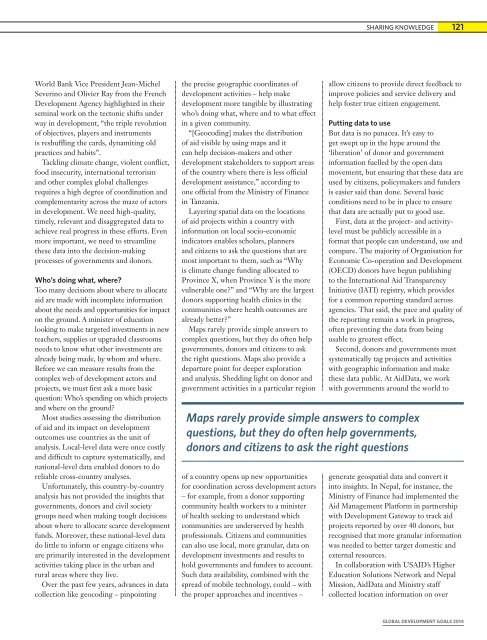FAMBB
FAMBB
FAMBB
You also want an ePaper? Increase the reach of your titles
YUMPU automatically turns print PDFs into web optimized ePapers that Google loves.
SHARING KNOWLEDGE121World Bank Vice President Jean-MichelSeverino and Olivier Ray from the FrenchDevelopment Agency highlighted in theirseminal work on the tectonic shifts underway in development, “the triple revolutionof objectives, players and instrumentsis reshuffling the cards, dynamiting oldpractices and habits”.Tackling climate change, violent conflict,food insecurity, international terrorismand other complex global challengesrequires a high degree of coordination andcomplementarity across the maze of actorsin development. We need high-quality,timely, relevant and disaggregated data toachieve real progress in these efforts. Evenmore important, we need to streamlinethese data into the decision-makingprocesses of governments and donors.Who’s doing what, where?Too many decisions about where to allocateaid are made with incomplete informationabout the needs and opportunities for impacton the ground. A minister of educationlooking to make targeted investments in newteachers, supplies or upgraded classroomsneeds to know what other investments arealready being made, by whom and where.Before we can measure results from thecomplex web of development actors andprojects, we must first ask a more basicquestion: Who’s spending on which projectsand where on the ground?Most studies assessing the distributionof aid and its impact on developmentoutcomes use countries as the unit ofanalysis. Local-level data were once costlyand difficult to capture systematically, andnational-level data enabled donors to doreliable cross-country analyses.Unfortunately, this country-by-countryanalysis has not provided the insights thatgovernments, donors and civil societygroups need when making tough decisionsabout where to allocate scarce developmentfunds. Moreover, these national-level datado little to inform or engage citizens whoare primarily interested in the developmentactivities taking place in the urban andrural areas where they live.Over the past few years, advances in datacollection like geocoding – pinpointingthe precise geographic coordinates ofdevelopment activities – help makedevelopment more tangible by illustratingwho’s doing what, where and to what effectin a given community.“[Geocoding] makes the distributionof aid visible by using maps and itcan help decision-makers and otherdevelopment stakeholders to support areasof the country where there is less officialdevelopment assistance,” according toone official from the Ministry of Financein Tanzania.Layering spatial data on the locationsof aid projects within a country withinformation on local socio-economicindicators enables scholars, plannersand citizens to ask the questions that aremost important to them, such as “Whyis climate change funding allocated toProvince X, when Province Y is the morevulnerable one?” and “Why are the largestdonors supporting health clinics in thecommunities where health outcomes arealready better?”Maps rarely provide simple answers tocomplex questions, but they do often helpgovernments, donors and citizens to askthe right questions. Maps also provide adeparture point for deeper explorationand analysis. Shedding light on donor andgovernment activities in a particular regionallow citizens to provide direct feedback toimprove policies and service delivery andhelp foster true citizen engagement.Putting data to useBut data is no panacea. It’s easy toget swept up in the hype around the‘liberation’ of donor and governmentinformation fuelled by the open datamovement, but ensuring that these data areused by citizens, policymakers and fundersis easier said than done. Several basicconditions need to be in place to ensurethat data are actually put to good use.First, data at the project- and activitylevelmust be publicly accessible in aformat that people can understand, use andcompare. The majority of Organisation forEconomic Co-operation and Development(OECD) donors have begun publishingto the International Aid TransparencyInitiative (IATI) registry, which providesfor a common reporting standard acrossagencies. That said, the pace and quality ofthe reporting remain a work in progress,often preventing the data from beingusable to greatest effect.Second, donors and governments mustsystematically tag projects and activitieswith geographic information and makethese data public. At AidData, we workwith governments around the world toMaps rarely provide simple answers to complexquestions, but they do often help governments,donors and citizens to ask the right questionsof a country opens up new opportunitiesfor coordination across development actors– for example, from a donor supportingcommunity health workers to a ministerof health seeking to understand whichcommunities are underserved by healthprofessionals. Citizens and communitiescan also use local, more granular, data ondevelopment investments and results tohold governments and funders to account.Such data availability, combined with thespread of mobile technology, could – withthe proper approaches and incentives –generate geospatial data and convert itinto insights. In Nepal, for instance, theMinistry of Finance had implemented theAid Management Platform in partnershipwith Development Gateway to track aidprojects reported by over 40 donors, butrecognised that more granular informationwas needed to better target domestic andexternal resources.In collaboration with USAID’s HigherEducation Solutions Network and NepalMission, AidData and Ministry staffcollected location information on overGLOBAL DEVELOPMENT GOALS 2014


